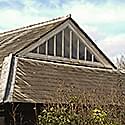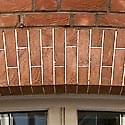
gauged arch, flat or curved arch constructed of high quality rubbed bricks with very fine lime putty joints.
‘Gauged’ in the sense of measured. The US spelling is ‘gage’, which applies also to the UK nautical word meaning the position of one vessel in relation to another and the wind; the Oxford English Dictionary describes the spelling ‘guage’ as ‘a mere blunder’. The example shown is a gauged flat arch (or straight arch), curved on plan.
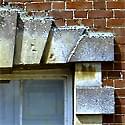
Gibbs surround, a banded architrave or columns around a door or window, popularised by the eighteenth century architect James Gibbs.
Gibbs had travelled to Italy intending to become a priest, but turned instead to architecture after being driven out of his college by an over–zealous and tyrannical regime. He trained in Rome under Carlo Fontana, a leading Roman architect, and brought back to England with him a familiarity with Italian baroque that was unique among contemporary architects.

glazing bar, (sash bar) a thin bar of wood or metal profiled to receive panes of glass.
See also astragal.
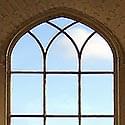
Gothic(k) arch, see pointed, four–centred, ogee, Florentine, Italian pointed, lancet, Strawberry Hill.
This is what Richard Neve, in The City and Country Purchaser and Builder’s Dictionary, 1726, had to say on the subject: “Gothick, or Modern Architecture, is that which is far remov’d from the Manner and proportions of the Antique, having its Ornaments wild and chimerical, and its Profiles incorrect”. By 1749 Horace Walpole, 4th Earl of Orford, man of letters, art historian, antiquarian and politician was remodelling his Twickenham villa, Strawberry Hill House in the Gothick style. T. H. White wrote in The Age of Scandal, 1950, that ‘the villa of Strawberry Hill, which he created, has been subjected to a certain amount of ill–natured fun, and, it might be added, to ill–informed fun, by the pomposity of architects. They say that it was not true Gothic, but bastard and degenerate. Walpole was one of the first people who paid attention to ‘Gothick’ architecture at all; it was not to be expected that he would understand its principles from the start. Nor did he intend the house to be taken seriously. It was a fantasy, half a joke; a fairy story in lath and plaster . . .’.
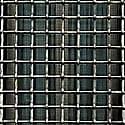
grille, grill, an open–work structure consisting of vertical and horizontal metal bars forming a security screen.

grouped sashes (1), a range of counterbalanced sashes butt–jointed and sharing common counterweight boxes forming one long horizontal window.
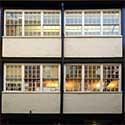
grouped sashes (2), a range of sashes operated either by spiral balances or by adjustable spring tape balances, and sharing common mullions.
In the example shown each run of windows consists of four tripartite windows — groups of three spring tape balance operated sashes — sitting between iron structural supports.
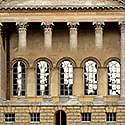
grouped serliana windows, a run of Venetian windows each coupled to the other.
Few if any examples exist other than in the mind of Joseph Gwilt, architect and writer, who in his An Encyclopaedia of Architecture (1842) writes ‘What are called Venetian windows are occasionally allowable, when so ranged and introduced so as not to interfere with the composition — a task often difficult to effect. They should not be much repeated, as in the front of Holkham, where they become actually DISGUSTING’ (author’s capitals). The tall semi–circular–headed windows are in fact too close together to allow for the insertion of useful windows, and so cannot have originally been conceived of as meriting the label ‘Venetian’. Perhaps Gwilt thought of the piers as blind windows purely for the purpose of making a derogatory remark, a circumstance unremarkable if true in an age noted for hypocrisy and sanctimoniousness.
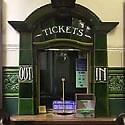
guichet, a ticket window [French: guichet, a hatch, counter, window, wicket gate].
The French ‘gu’ sound translates into the English ‘w’ (Guillaume = William), and the soft ‘ch’ becomes the hard ‘ck’, giving us, with a sounded ‘T’ — ‘wicket’. A word not much used, except by Evelyn Waugh, who found reasons to employ it in several of his novels in connection with the cinema and with railways — “The complexity of the situation was impressed on me when I attempted to buy my railway ticket from Dirediwa to Addis. I came to the guichet with a wallet full of lire and francs. The clerk informed me I must pay in thalers”. (Waugh in Abyssinia, 1936).
guilloche, a band of Classical ornament consisting of intertwining circular forms.
gun–loop, see arrow–loop.
guaged arch, see gauged arch.



